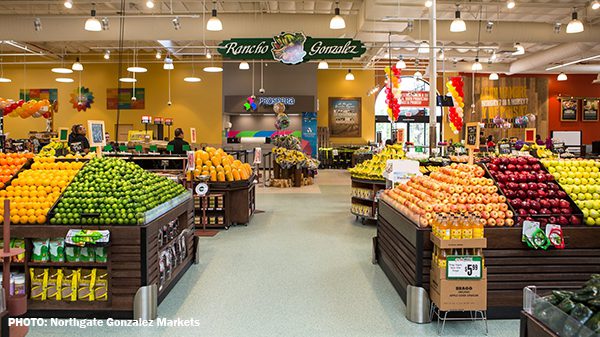The Northgate stores are famous for their bakeries, tortillerías, salsa bars, cocinas, agua fresca stands, and diversity of hard-to-find products, like hoja santa or chayote, that make Latino shoppers feel right at home.
Over the past few decades, as the Latino population has grown, so has the demand for stores that offer what these shoppers want: everything from chiles and cherimoya to papayas and plantains.
In essence, they want foods and products from home.
So, when mainstream grocers were, at first, slow out of the gate, specialty retailers began stepping in to fill the void. The trend began with a few regional chains here and there in the 1980s, then accelerated dramatically.
“A dedicated Hispanic supermarket offers authentic products throughout all the departments in the store that appeal to the Hispanic shopper,” says Brian Numainville, principal at the Lake Success, NY-based Retail Feedback Group, a consumer.
“This is far different than a store that simply has a ‘Hispanic product’ section or includes a sprinkling of products throughout the store.”
And while many big box grocers, recognizing a potentially profitable market, have added
a shelf or two or an entire aisle dedicated to “Latino” or “International” foods, it’s not the same as having an entire store dedicated to engaging interest or appetite.
Atmosphere and selection
When it comes to décor, layout, and ambiance, this is where Latino supermarket retailers can differ greatly from their more mainstream competitors. They offer a format and feel, usually with bold colors, prominent displays, and upbeat attitude, that appeal to Latino shoppers.
It’s no mistake the stores are built to look like markets in shoppers’ home countries, like in Mexico or El Salvador or the Dominican Republic.
Want fresh tortillas? Check out the tortillería. Baked goods or quinceañera cakes? Head to the panadería or the pastelería.
And for those who want a home-cooked meal but don’t feel like cooking, check out the cocina (kitchen), which can feature anything from traditional carnitas and fresh tamales to guava-filled tequeños, arroz con pollo and Cuban sandwiches known as medianoches.
“For me, they imitate a mercado in Mexico,” says Carlos Villa, president of Nogales, AZ-based Higueral Produce, Inc. BB #:192110. “They have everything shoppers want, and that makes it special.”
Also of note, he says, is “people who work there treat you more like family because these stores aren’t typically as big. And you can locate everything easily.”
Jorge Vázquez, president of Houston, TX-based importer/exporter Latin Specialties, LLC, BB #:165092 adds that these retailers, while not as deep-pocketed as big box rivals or some traditional supermarkets, fully understand the culture.
“They communicate with their clientele better in the channels that have traditionally been most effective in reaching Latinos—channels like bilingual media and print ads,” he says.
This is a multi-part feature adapted from a supplement to the September/October issue of Produce Blueprints magazine.
Over the past few decades, as the Latino population has grown, so has the demand for stores that offer what these shoppers want: everything from chiles and cherimoya to papayas and plantains.
In essence, they want foods and products from home.
So, when mainstream grocers were, at first, slow out of the gate, specialty retailers began stepping in to fill the void. The trend began with a few regional chains here and there in the 1980s, then accelerated dramatically.
“A dedicated Hispanic supermarket offers authentic products throughout all the departments in the store that appeal to the Hispanic shopper,” says Brian Numainville, principal at the Lake Success, NY-based Retail Feedback Group, a consumer.
“This is far different than a store that simply has a ‘Hispanic product’ section or includes a sprinkling of products throughout the store.”
And while many big box grocers, recognizing a potentially profitable market, have added
a shelf or two or an entire aisle dedicated to “Latino” or “International” foods, it’s not the same as having an entire store dedicated to engaging interest or appetite.
Atmosphere and selection
When it comes to décor, layout, and ambiance, this is where Latino supermarket retailers can differ greatly from their more mainstream competitors. They offer a format and feel, usually with bold colors, prominent displays, and upbeat attitude, that appeal to Latino shoppers.
It’s no mistake the stores are built to look like markets in shoppers’ home countries, like in Mexico or El Salvador or the Dominican Republic.
Want fresh tortillas? Check out the tortillería. Baked goods or quinceañera cakes? Head to the panadería or the pastelería.
And for those who want a home-cooked meal but don’t feel like cooking, check out the cocina (kitchen), which can feature anything from traditional carnitas and fresh tamales to guava-filled tequeños, arroz con pollo and Cuban sandwiches known as medianoches.
“For me, they imitate a mercado in Mexico,” says Carlos Villa, president of Nogales, AZ-based Higueral Produce, Inc. BB #:192110. “They have everything shoppers want, and that makes it special.”
Also of note, he says, is “people who work there treat you more like family because these stores aren’t typically as big. And you can locate everything easily.”
Jorge Vázquez, president of Houston, TX-based importer/exporter Latin Specialties, LLC, BB #:165092 adds that these retailers, while not as deep-pocketed as big box rivals or some traditional supermarkets, fully understand the culture.
“They communicate with their clientele better in the channels that have traditionally been most effective in reaching Latinos—channels like bilingual media and print ads,” he says.
This is a multi-part feature adapted from a supplement to the September/October issue of Produce Blueprints magazine.



